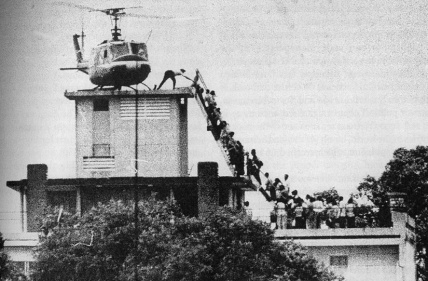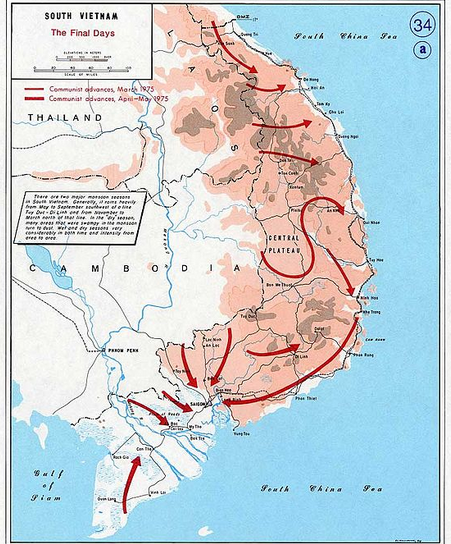The Day Before

Dutch photographer Hubert van Es caught this image of the last helicopter to leave Saigon before the city fell. He stayed, and observed the transition. The helicopter could not accommodate all those that wished to depart, and van Es reported the ones who were left behind waited for hours, hoping for another to arrive and take them to the Navy ships waiting offshore. None came. Photo Hubert van Es).
I was at Willow last night, like that is something unusual. What came up was, though.
Nguyen stopped by on the way to something else, and we got to talking about Vietnam, as we often do. He was born there, and has the usual stories of those that fled the Communist regime. He is a bit of an activist, well connected in émigré circles, so he is not going back any time soon.
“It was this week, wasn’t it?” I asked, not recalling the exact day, though once I had to give a speech about it.
“General Van Tien Dung launched the final attack on the city on the 29th. The City fell the next day.”
“Forty years ago,” I said in wonder. “I had to give the speech on the 20th anniversary. that was half-way to this week, and most of my adult life.”
“The last Americans were killed in a rocket attack on Tan Son Nhut airfield on the 29th. Then it was over. Or maybe it is better to say that something else was just beginning. Like the rest of my life.” He took a pensive sip of Willow’s happy hour white.
I nodded, making a note to look it up later, and we went back to drinking and talking about the strange things that happen in Washington. I was not quite half in the bag when I got home, and thought about the significance of the day. I checked Google. The last two Americans killed on the land-mass of Vietnam were (L-R) Charles McMahon and Darwin Judge. Here is what they looked like in life:

Their bodies were transferred to the Seventh Day Adventist Hospital nearby. In the confusion, their bodies were inadvertently left behind, and it took Senator Ted Kennedy to get them back almost a year later. That might have been the start of the long process that preceded the mission that caused the speech- and a few other issues like normalization of relations- twenty years later.
Jake told me the story of the collapse as he saw it from the Chief of Naval Operations Intelligence Plot. He was a Lieutenant then, one of the briefing officers to the Navy leadership. He had previously done a year’s tour in country to buttress his appreciation of the situation, and increasingly it was dire.
The leadership was surprised when the young officers were permitted by the Commander in Charge to make a frank assessment. He would later be the Director of Naval Intelligence, as was Jake, and their courage in telling the truth was a hallmark of their integrity. The CIA, for example, was on record as saying that the South could hold out through the dry season, or at least until 1976, and the Army concurred in the National Intelligence Estimate.
The NIE came out in March, just Corporal McMahon was reporting to the MARDET. That is precisely when things were starting to unravel. General Dung was preparing a major offensive in the Central Highlands. When he unleashed his forces, it caused the ARVN to begin a disorderly retreat, hoping to establish a defensible position somewhere north of Saigon.

That didn’t happen. It was a rout, and Congress showed no interest in getting engaged once more in the conflict. I remember President Ford on the television with his charts about what was needed to save our ally. As the North closed in on Saigon, , Jake predicted the imminent fall of the capital in the morning briefing.
One of the Admiral’s in the audience looked stunned. Everyone in the room had spent the last two decades of their careers supporting the war. The Admiral asked in amazement: “It’s over?”
Jake nodded and went on with the briefing.
Copyright 2015 Vic Socotra
www.vicsocotra.com
Twitter: @jayare303
Editor’s note: Operation Frequent Wind, the evacuation to sea by helicopter, was in progress, wrapping up on April 30th. Our pal the Master Chief was there, embarked in USS Midway, CV-41. I will get you a first person view of the last combat-related action in the waters off Vietnam. I am not forgetting the Mayaguez incident later. And I will tell you about the speech, too.
